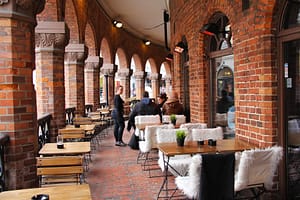Akershus Fortress
Rising above the Oslofjord on the promontory of Akernes sits the majestic Akershus Fortress, built by Håkon V at the end of the 13th Century. Take your time to wander the grounds and ramparts with their wonderful harbor views before exploring the quaint chapel with its tomb of Håkon VII (1872-1957) and the remains of the original medieval castle. Also located in the grounds is the Museum of the Norwegian Resistance. Be prepared to spend a few hours here learning about the German occupation of 1940-45. If you’ve any energy left, head over to the Norwegian Armed Forces Museum in Oslo’s old Arsenal with its displays of weapons and exhibits illustrating the history of the Norwegian forces and the defense of Norway down the centuries.
Royal Palace
Located high up on the northwest end of Karl Johansgate, the Norwegian Royal Palace, built in 1825, dominates the cityscape. The impressive 173-room building is open to the public for guided tours during the summer only, with English-language guides four times daily. Tours include the Cabinet Parlour and Cloakroom, the White Parlour, Mirror Hall, Great Hall, Banquet Hall, and other significant rooms in the palace. Visitors are also free to wander the grounds and gardens or watch the regular changing of the guard year-round. Just to the south of the palace sits the Norwegian Nobel Institute, where the Nobel Peace Prize is presented.
Oslo Cathedral
Although consecrated in 1697, Oslo’s Cathedral has been rebuilt and renovated numerous times. Its tower was rebuilt in 1850, while its interior was renovated soon after the end of WWII. Notable features include the main doorway with its decorated bronze doors, as well as the ceiling paintings by H. L. Mohr, the Baroque pulpit and altar (1699), and the stained glass by Emanuel Vigeland. Afterwards, be sure to visit the Oslo Bazaar along the old church walls. Dating back to 1841, these fascinating halls are now occupied by galleries, cafés and antique dealers.
City Hall (Rådhuset)
Oslo’s enormous City Hall (Rådhuset) is undoubtedly one of the city’s great landmarks. This imposing square building, built of concrete faced with brick, was designed by Arnstein Arneberg and Magnus Poulson and has two towers, one of them adorned with a huge clock face. One of the towers houses the 38 bells that can be heard chiming throughout the harbor area. Along with its fascinating facade with its sculptures and reliefs, the interior is also worth a visit, boasting a rich fresco created by Henrik Sørensen, Per Krohg, Edvard Munch and other famous Norwegian artists.
Aker Brygge
Built around an abandoned shipyard, Oslo’a Aker Brygge area is the heart and soul of the city. Bustling and vibrant day and night, its stunning architecture – that magnificent blend of new and old that perfectly compliments Norway’s stunning natural beauty – is everywhere on display, and everywhere breathtaking. It’s estimated that 12 million visitors find their way to Aker Brygge every year, drawn by its sea-front boardwalk, fine shopping, great restaurants, and cozy year-round patio bars with their snug rugs and fireplaces. While visiting, be sure to pop into the newly opened Astrup Fearnley Museum of Modern Art. The museum consists of two buildings: one for its own collection of works by such greats as Andy Warhol, Damien Hirst, and Jeff Koons, the other for rotating exhibitions.
Oslo Opera House and Annual Music Festivals
Home to the Norwegian National Opera and Ballet, as well as the National Opera Theatre, the 1,364-seat Oslo Opera House seems to almost want to slip into the city’s harbor, an effect exaggerated by its angled exterior surfaces. Clad in Italian marble and white granite, the Opera House is the largest cultural building constructed in Norway since Trondheim’s Nidaros Cathedral in the 14th century. In addition to its many performances, visitors can also participate in a variety of interesting public programs and behind-the-scenes tours, as well as enjoy the views from a stroll on the building’s roof.

